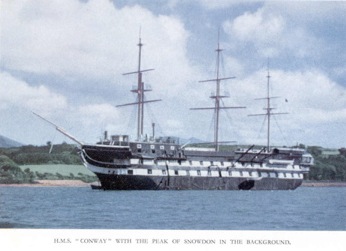| HMS Conway 1859 - 1974 © Alfie Windsor 1998 |
||
|
This site is dedicated to those Conways who gave their lives in the two world wars and to the nine captain superintendents and a 'headmaster superintendent' who gave so many so much. The ship was our wooden mother, they were our stern father.
There was a time, not too long ago when the British merchant fleet was larger than all of the rest of the world's merchant navies combined. This was perhaps the pinnacle of hundreds of years of British maritime tradition when Britain really did 'Rule The Waves'. This created a huge and constant need for young men trained for the challenge of a rigorous life at sea. A life that was hard and required the highest standards of training, performance, leadership and personal example. This demand accelerated during the two World Wars. HMS Conway existed to answer this demand and was something special in Britain's maritime tradition. For over 100 years from 1859 a series of three Royal Navy 'wooden walls', and then a 'stone frigate' were used to train 11,000 young boys for a life as officers in the British Royal and Merchant Navies as well as navies and other maritime organisations around the world. Conways have served in over 683 shipping organisations and 180 uniformed services around the world. Cadets arrived as boys and left, about two years later, as men, true to the ship's motto: "Quit ye like men, be strong". A special breed of men who continue to have a strong influence in all walks of life around the world. The record includes at least 26 Admirals, 13 Commodores RN, 3 Army Generals, 4 Air Marshals, at least 17 Commodores of Shipping Companies, 4 VCs, 4 George Medal/George Cross/Albert Medals, a Poet Laureate and a staggering array of other accomplishments at sea and ashore around the world. The extent of this achievement is summarised in A Career At Sea? For many years HMS Conway was accommodated onboard a succession of Royal Navy wooden warships, the most recent was originally HMS Nile, a two-decker, which was lent by the Royal Navy to Liverpool's Mercantile Marine Service Association as the School Ship Conway in 1875. 
She was moored in the River Mersey, off Rock Ferry, Birkenhead. During WW II she was moved to the Menai Strait in North Wales to avoid the Merseyside Blitz. In 1953 Conway went aground underneath the Menai Suspension Bridge whilst being towed for a re-fit and was declared a total loss. The ship's proud traditions continued with the training of cadets from a shore base at Plas Newydd on the Marquis Of Anglesey's estate (now in the hands of the National Trust and Cheshire County Council). Times change, empires fade, priorities alter and Britain's reliance on a strong merchant marine declined rapidly. The demand for men faded, the ship sadly closed her doors and paid off in 1974. However new 'Conway Cadets' are still going to sea. See A proud tradition continues The main aims of the HMS Conway site are to:
Acknowledgements Finally this site has had a tremendous input from many people and our thanks go to all of them for the information and images they have provided. Our especial thanks go to those who are not Old Conways but who, none the less, have taken the time to fill in gaps in our knowledge. |
||
| Page Last Modified (D/M/Y): 29/7/03 |